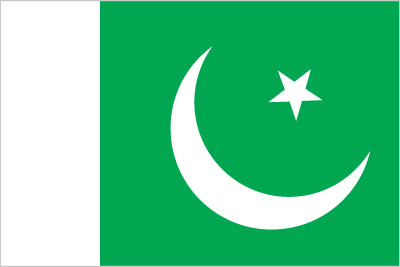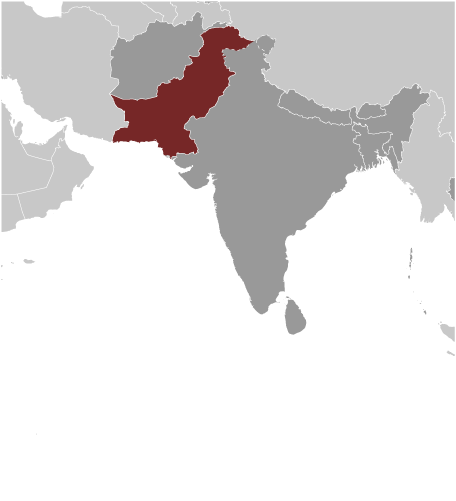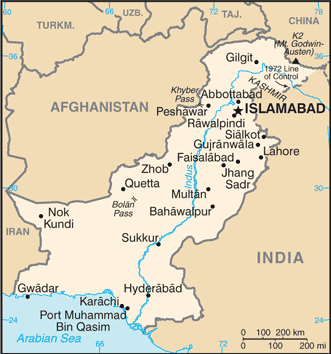|
Country name:
|

|
|
conventional long form: Islamic Republic of Pakistan
conventional short form:
Pakistan
local long form:
Jamhuryat Islami Pakistan
local short form:
Pakistan
former:
West Pakistan
|
|
|
Government type:
|

|
|
federal republic
|
|
|
Capital:
|

|
|
name: Islamabad
geographic coordinates:
33 41 N, 73 03 E
time difference:
UTC+5 (10 hours ahead of Washington, DC during Standard Time)
|
|
|
Administrative divisions:
|

|
|
4 provinces, 1 territory*, and 1 capital territory**; Balochistan, Federally Administered Tribal Areas*, Islamabad Capital Territory**, Khyber Pakhtunkhwa (formerly North-West Frontier Province), Punjab, Sindh
note:
the Pakistani-administered portion of the disputed Jammu and Kashmir region consists of two administrative entities: Azad Kashmir and Gilgit-Baltistan
|
|
|
Independence:
|

|
|
14 August 1947 (from British India)
|
|
|
National holiday:
|

|
|
Republic Day, 23 March (1956)
|
|
|
Constitution:
|

|
|
12 April 1973; suspended 5 July 1977, restored 30 December 1985; suspended 15 October 1999, restored in stages in 2002; amended 31 December 2003; suspended 3 November 2007; restored 15 December 2007; last amended 28 February 2012
|
|
|
Legal system:
|

|
|
common law system with Islamic law influence
|
|
|
International law organization participation:
|

|
|
accepts compulsory ICJ jurisdiction with reservations; non-party state to the ICCt
|
|
|
Suffrage:
|

|
|
18 years of age; universal; note - there are joint electorates and reserved parliamentary seats for women and non-Muslims
|
|
|
Executive branch:
|

|
|
note: the country has a caretaker government until the next general election set for 11 May 2013 and a new government is formed
chief of state:
President Asif Ali ZARDARI (since 9 September 2008)
head of government:
Prime Minister (Caretaker) Mir Hazar Khan KHOSO
cabinet:
Cabinet appointed by the president upon the advice of the prime minister
(For more information visit the World Leaders website  ) )
elections:
president elected by secret ballot through an Electoral College comprising the members of the Senate, National Assembly, and provincial assemblies for a five-year term; election last held on 6 September 2008 (next to be held on 11 May 2013); note - any person who is a Muslim and not less than 45 years of age and qualified to be elected as a member of the National Assembly can contest the presidential election; the prime minister selected by the National Assembly
election results:
Asif Ali ZARDARI elected president; Asif Ali ZARDARI 481 votes, Saeeduzzaman SIDDIQUE 153 votes, Mushahid HUSSAIN 44 votes; Prime Minister Raja Pervais ASHRAF elected by Parliament - Raja Pervais ASHRAF 211 votes, Sardar Mehtab ABBASI 89 votes
|
|
|
Legislative branch:
|

|
|
bicameral parliament or Majlis-e-Shoora consists of the Senate (104 seats; members indirectly elected by provincial assemblies and the territories' representatives in the National Assembly to serve six-year terms; one half are elected every three years) and the National Assembly (342 seats; 272 members elected by popular vote; 60 seats reserved for women; 10 seats reserved for non-Muslims; members serve five-year terms)
elections:
Senate - last held on 2 March 2012 (next to be held in March 2015); National Assembly - last held on 18 February 2008 (next to be held on 11 May 2013)
election results:
Senate - percent of vote by party - NA; seats by party - PPPP 41, PML-N 14, ANP 12, JUI-F 7, MQM 7, PML-Q 5, BNP-A 4, NPP 1, PML-F 1, independents 12; National Assembly - percent of votes by party - NA; seats by party as of November 2012 - PPPP 125, PML-N 92, PML-N 50, MQM 24, ANP 13, JUI-F 8, PML-F 5, BNP-A 1, NPP 1, PPP-S 1, independents 18, unfilled seats - 4
|
|
|
Judicial branch:
|

|
|
Supreme Court (justices appointed by the president); Federal Islamic or Sharia Court
|
|
|
Political parties and leaders:
|

|
|
Awami National Party or ANP [Asfandyar Wali KHAN]; Balochistan National Party-Awami or BNP-A; Balochistan National Party-Hayee Group or BNP-H [Dr. Hayee BALOCH]; Balochistan National Party-Mengal or BNP-M; Jamaat-i Islami or JI [Syed Munawar HASAN]; Jamhoori Watan Party or JWP; Jamiat Ahle Hadith or JAH [Sajid MIR]; Jamiat-i Ulema-i Islam Fazl-ur Rehman or JUI-F [Fazl-ur REHMAN]; Jamiat-i Ulema-i Islam Sami-ul HAQ or JUI-S [Sami ul-HAQ]; Jamiat-i Ulema-i Pakistan or JUP [Abul Khair ZUBAIR]; Millat-e-Jafferia [Allama Sajid NAQVI]; Muttahida Qaumi Movement or MQM [Altaf HUSSAIN]; National Peoples Party or NPP; Pakhtun-khwa Milli Awami Party or PKMAP [Mahmood Khan ACHAKZAI]; Pakistan Awami Tehrik or PAT [Tahir ul QADRI]; Pakistan Muslim League-Quaid-i Azam or PML-Q [Chaudhry Shujaat HUSSAIN]; Pakistan Muslim League-Functional or PML-F [Pir PAGARO]; Pakistan Muslim League-Nawaz or PML-N [Nawaz SHARIF]; Pakistan Peoples Party Parliamentarians or PPPP [Bilawal Bhutto ZARDARI, chairman; Asif Ali ZARDARI, co-chairman]; Quami Watan Party or QWP [Aftab Ahmed Khan SHERPAO]; Pakistan Tehrik-e Insaaf or PTI [Imran KHAN]
note:
political alliances in Pakistan can shift frequently
|
|
|
Political pressure groups and leaders:
|

|
|
other: military (most important political force); ulema (clergy); landowners; industrialists; small merchants
|
|
|
International organization participation:
|

|
|
ADB, ARF, ASEAN (dialogue partner), C, CICA, CP, D-8, ECO, FAO, G-11, G-24, G-77, IAEA, IBRD, ICAO, ICC (national committees), ICRM, IDA, IDB, IFAD, IFC, IFRCS, IHO, ILO, IMF, IMO, IMSO, Interpol, IOC, IOM, IPU, ISO, ITSO, ITU, ITUC (NGOs), LAIA (observer), MIGA, MINURSO, MONUSCO, NAM, OAS (observer), OIC, OPCW, PCA, SAARC, SACEP, SCO (observer), UN, UNAMID, UNCTAD, UNESCO, UNHCR, UNIDO, UNISFA, UNMIL, UNMIT, UNOCI, UNSC (temporary), UNWTO, UPU, WCO, WFTU (NGOs), WHO, WIPO, WMO, WTO
|
|
|
Diplomatic representation in the US:
|

|
|
chief of mission: Ambassador Sheherbano REHMAN
chancery:
3517 International Court, Washington, DC 20008
telephone:
[1] (202) 243-6500
FAX:
[1] (202) 686-1534
consulate(s) general:
Chicago, Houston, Los Angeles, New York, Sunnyvale (CA)
consulate(s):
Chicago, Houston
|
|
|
Diplomatic representation from the US:
|

|
|
chief of mission: Ambassador Richard OLSON
embassy:
Diplomatic Enclave, Ramna 5, Islamabad
mailing address:
8100 Islamabad Pl., Washington, DC 20521-8100
telephone:
[92] (51) 208-0000
FAX:
[92] (51) 227-6427
consulate(s) general:
Karachi
consulate(s):
Lahore, Peshawar
|
|
|
Flag description:
|

|
|
green with a vertical white band (symbolizing the role of religious minorities) on the hoist side; a large white crescent and star are centered in the green field; the crescent, star, and color green are traditional symbols of Islam
|
|
|
National symbol(s):
|

|
|
star and crescent
|
|
|
National anthem:
|

|
|
name: "Qaumi Tarana" (National Anthem)
lyrics/music:
Abu-Al-Asar Hafeez JULLANDHURI/Ahmed Ghulamali CHAGLA
note:
adopted 1954; the anthem is also known as "Pak sarzamin shad bad" (Blessed Be the Sacred Land)
|
|
|
|
|





 )
)



